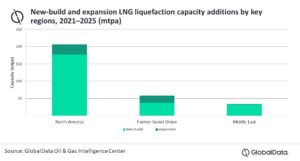North America is expected to lead the global liquefied natural gas (LNG) liquefaction capacity additions by 2025, contributing around 63 percent, says GlobalData, a leading data and analytics company. The Former Soviet Union (FSU) region is a distant second place, with 18 percent, followed by the Middle East at 10 percent.
GlobalData’s latest report, “Global Capacity and Capital Expenditure Outlook for LNG Liquefaction Terminals, 2021–2025,” reveals that North America’s new-build and expansion projects will see additions of 206 mtpa (million tonnes per annum) between 2021 and 2025.
Bhargavi Gandham, Oil and Gas Analyst at GlobalData, comments: “In North America, the United States primarily drives liquefaction capacity additions by 2025 and beyond. Though COVID-19 triggered project delays and postponement of a few projects in the United States, it is on track to become the global leader banking on vast shale gas deposits, surpassing the traditional leaders—Australia and Qatar. Canada is also relying on its abundant natural gas resources to add liquefaction capacity for exports.”
Among the countries, the United States is expected to account for 46 percent of global LNG liquefaction capacity additions. It will be the highest contributing country in North America, with an expected LNG liquefaction capacity of 126mtpa. The FSU’s highest contributor will be Russia with 37.6mtpa of additions, and Qatar will be the star for the Middle East at 32mtpa.
The largest projects in each region include Plaquemines in the United States, with a capacity of 20 mtpa by 2025; Arctic-2 Floating in Russia, with 19.8 mtpa by 2025; and Ras Laffan North Field Expansion in Qatar, with 32 mtpa by 2025.











